The Women’s Land Army (WLA) was created in 1917, by the Board of Agriculture. WLA members, or Land Girls as they were more popularly known, were employed to meet the shortfall in agricultural labour caused by conscription of men to fight at the Front.
After the First World War the WLA was disbanded but was re-founded in June 1939 as part of the government’s efforts to mobilise the nation for war. At its peak in 1944 it had 80,000 members.
The National Archives has a vast collection of documents about the Women’s Land Army, including administrative files, examples of propaganda and a wonderful collection of photographs.
Worn with pride
Land Girls wore a uniform including practical breeches, green jumpers and felt hats. This Board of Agriculture file (MAF 42/8) contains a sample, from the First World War, of an armlet issued to Land Girls. The file shows an order for 50,000 in June 1918 at a cost of £1,500.
Serving their country
Government officials were always looking at ways to reward and encourage women – especially middle class ladies – to sign up. In the same file as the armlet (MAF 42/8) there is also a copy of the certificate given to women during the First World War for their part in serving their country.
How to milk a cow
During the Second World War one third of the Women’s Land Army were from London and other large cities. As Jose Loosemore recollected as part of the BBC’s WW2 People’s War:
‘It was really quite wonderful how these town girls, never having seen milk other than in bottles on doorsteps…quickly learned’.[ref]1. Jose Loosemore, WW2 People’s War. WW2 People’s war is an online archive of memories contributed by members of the public and gathered by the BBC. The archives can be found at bbc.co.uk/WW2peopleswar[/ref]
As you can see from this photo, girls were trained using artificial cows with fake udders. I would have thought a real cow would have been a trickier beast to manage!
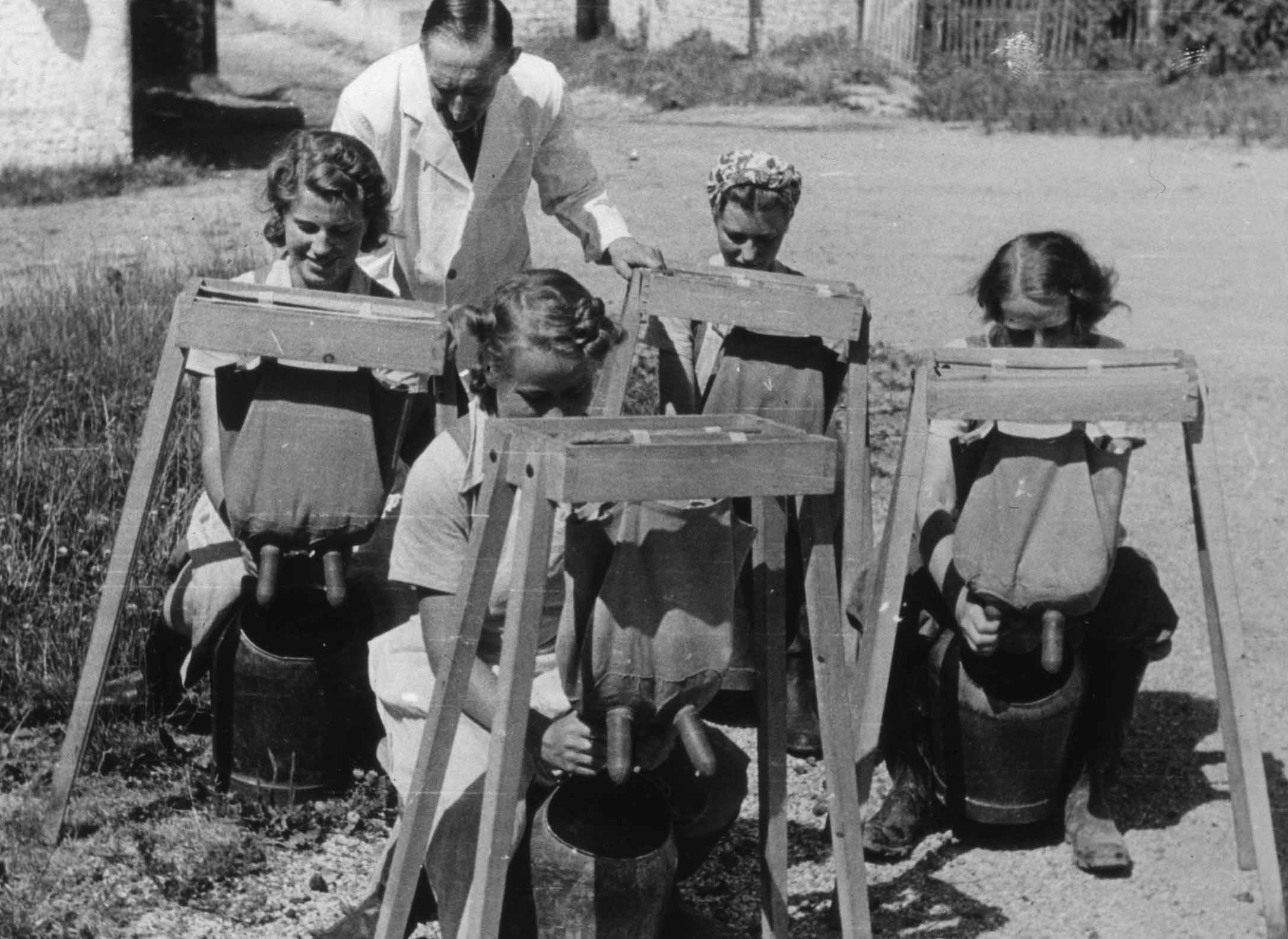
Women’s Land Army training (catalogue reference MAF 59/154)
War art
Jose Loosemore also recollects ‘another memory of these hectic days, which left a lasting happy impression on me, was the arrival at the farm institute of an official British war artist, the late Miss Evelyn Dunbar. She came to record on paint and canvas “women at war”. Several of her works now hang in IWM, of her studies of land girls, which she painted at Sparsholt. I am proud of the fact that a figure in the foreground of one is me as sweet 17 in my green/white dairy uniform rolling a churn across the dairy floor.'[ref]2. Jose Loosemore, WW2 People’s War[/ref]
A quick search in IWM’s catalogue revealed the above painting, which surely must be the same one! Photographs here at The National Archives depict similar scenes, also above.
Tin hats for all!
As you may have spotted in the previous picture, the Land Girls were all wearing tin hats.
Issued in Southern England, the hats were to protect the women from flying shrapnel caused by home defences shooting down the flying bombs. As the reverse of one such picture said, ‘The Women’s Land Army are really ‘Front Line Girls’ (MAF 59/143).
Training
The training Women’s Land Army volunteers received was varied. Some were fortunate to be sent to agricultural colleges for special training, others were placed on farms and some just got stuck in! Peace-time training wasn’t provided directly from the government, apart from tractor driving.
This file shows that at the beginning of the war a ‘go slow’ approach was adopted.
It was felt that training was not required immediately at the outbreak of war. Lady Denman, Honorary Director, of the Woman’s Land Army, was also concerned that peace-time training might put off volunteers as they would be discouraged by experiencing farm life, whereas in war time, they would be ‘more prepared to make the necessary sacrifices of comfort’(MAF 59/7).
Signing up
The Government learnt from the First World War that it was ‘desirable to set up a separate branch of the ministry, staffed by women, to deal with the problems which will arise in connection with the employment of women on the land’ (MAF 59/7).
County Committees ran all aspects of the WLA – uniform supply, supervision, training, recruitment, and propaganda. They had a budget for propaganda and produced leaflets and posters, were responsible for recruitment drives and sending information and publicity to their local press.
From chiropodist to front line
Within our collection of photographs there is sometimes wonderful detail on named individuals, such as Miss Heddle, seen here at the wheel of her tractor.
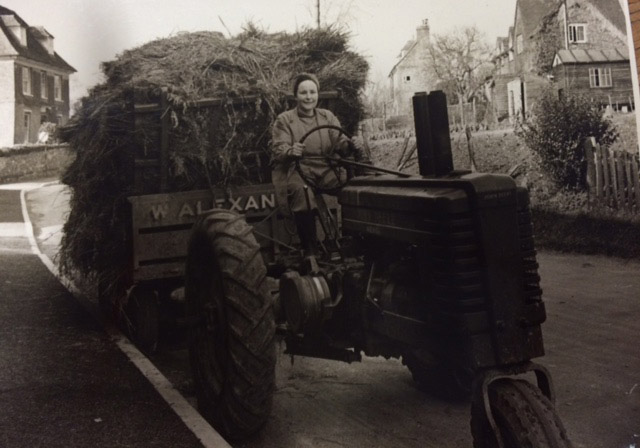
Miss Heddle on a tractor (catalogue reference MAF 59/145)
The caption on the reverse reads:
‘From chiropodist to front line.
It’s a long way from being a chiropodist to an expert Land Girl, but that is the achievement of Miss Heddle a member of the Women’s Land Army, now engaged on farm duties at “Home Farm” – Kent. Miss Heddle is 27 years old next month, and was a chiropodist for 4 years up to joining the Women’s Land Army.’
Researching the Women’s Land Army
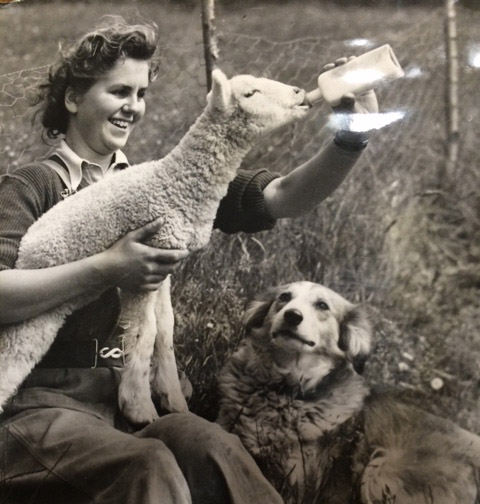
Land girl feeding a lamb (catalogue reference MAF 59/153)
Records about the Women’s Land Army are available in our reading rooms at Kew. This research guide outlines what we have and you can also search in Discovery to find records held elsewhere. There is also a selection of photographs and propaganda material in our image library.
While researching the WLA I discovered the wonderful People’s War archive, containing first-hand accounts from hundreds of Land Girls. With such a wealth of information, it has been hard to do the subject justice, so I hope that I can cover some aspects, in more detail, in future blogs.
Although girls and women had different experiences and were motivated by different reasons, I felt an affinity with Hilda Dison who said:
‘My reason for joining the Land Army was because I loved the countryside and animals and wanted to help with the war effort’.[ref]3. Hilda Dison, WW2 People’s War[/ref]
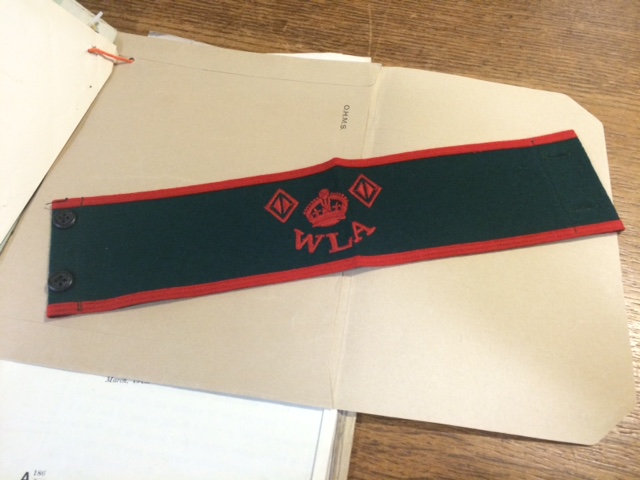


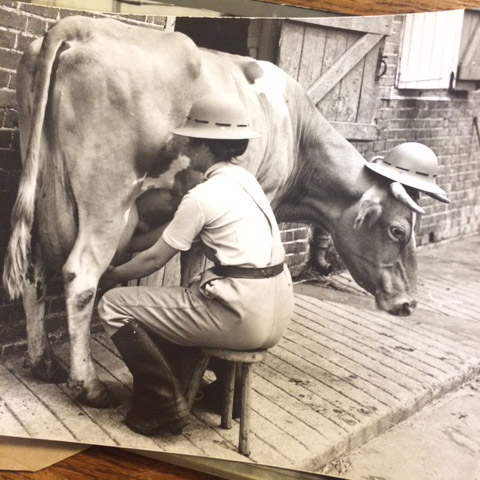

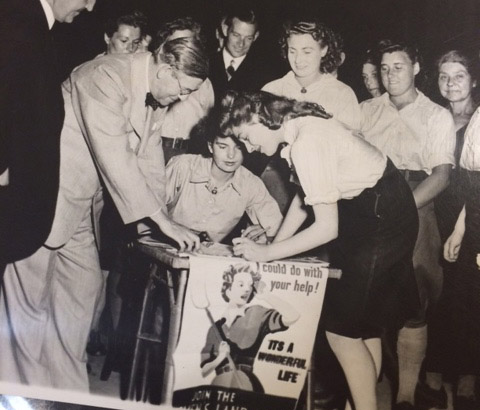
[…] techadmin on March 24, 2016 The Women’s Land Army in eight documents2016-03-24T10:14:17+00:00 – Journals & Publications – No […]
Hello Laura
Just to let you know that the first illustration shown of a WLA armband is incorrectly labelled as being from the First World War. It actually shows a Second World War WLA armband of a land girl who has served two years.
If you come back to me I will send you references and illustrations to show how very different First World War armbands were in quality compared with WW2 ones.
If the MAF catalogue entry for this particular armband is also incorrect the relevant National Archives curator will need to be alerted so that an amendment can be made.
Regards
Stuart Antrobus
Women’s Land Army historian
Bedford
Hi Stuart,
Thank you so much for your comment. I’d be very interested to see the illustrations you have. If they’re easier to share by email, please could you send them to marketing@nationalarchives.gov.uk
The file I found the armlet in is from 1917-18 (http://discovery.nationalarchives.gov.uk/details/r/C6223622). I will reorder it and we’ll investigate! The file referenced an order in June 1918 – maybe it was cancelled, or they weren’t issued as the war was over only a few months later? But maybe they re-used the design? Intriguing!
Best wishes, Laura
Dear Mr Antrobus. As you are a WLA historian I am hoping that you can tell me why the WW2 arm bands came in three different colours red,green and yellow. I recently gave a talk on the WLA to The Banbury Steam Society and this question was posed to me. The arm bands may have come in other colours as well.
Hoping that you can shed some light on this
Many thanks Robert Manton local historian.
I have a short excerpt from a diary my my mum wrote whilst she was in the land army. It makes quite charming reading. It was written in pencil and not all easy to read. Some years ago I did my best to type it up. Would you be interested in it.
Judy Kilner
Hi Laura,
In reference to the second world war armband that is listed as a first world war one – the design of the first world war one formed the basis for the design of the onesthat followed in the second world war with the most obvious difference being the embroidering of the crown as opposed to the sewing on of a felt crown cutout.
At the start of 1939 the older stock was issued which is why some early accounts refer to armbands being worn by landgirls with the crown sewn on from felt rather than embroidery.
In 1939 they were recommissioned to be made with some slight design alterations – each 6 months of service would be denoted by the issue of a red felt half diamond which was to be sewn on by the wearer – the one in the picture is indeed a two year armband as it already shows the 4 half diamonds already embroidered on the band itself. The four year armband was made in red felt with green embroidery, the six year was yellow felt with green embroidery and the 8 year is a combination of green and yellow felt with red embroidery – there was no 10 year armband, instead a special badge was made for the few women who had 10 year continous service in the small window of opportunity from June 1939 until October 1949 when the WLA was offically disbanded.
I love the picture of the girls in helments rolling the milk barrells – I have had many accounts from ex WLA veternas of how those civil defence issue helments have saved lives and the bladders of a landgirl in the fields of Kent!
Nicky Reynolds
WLA Collector andLiving Historian.
My mother June Godden was in the land army. She is approaching 95 years and has spoken of the land army days and has a photo of her with other land army friends. I believe she drove a tractor as part of her work. She has often spoken of her days.
Regards Jeanette Locke (daughter)